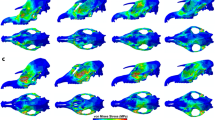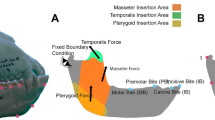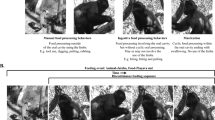Abstract
The origins of the genus Homo are murky, but by H. erectus, bigger brains and bodies had evolved that, along with larger foraging ranges, would have increased the daily energetic requirements of hominins1,2. Yet H. erectus differs from earlier hominins in having relatively smaller teeth, reduced chewing muscles, weaker maximum bite force capabilities, and a relatively smaller gut3,4,5. This paradoxical combination of increased energy demands along with decreased masticatory and digestive capacities is hypothesized to have been made possible by adding meat to the diet6,7,8, by mechanically processing food using stone tools7,9,10, or by cooking11,12. Cooking, however, was apparently uncommon until 500,000 years ago13,14, and the effects of carnivory and Palaeolithic processing techniques on mastication are unknown. Here we report experiments that tested how Lower Palaeolithic processing technologies affect chewing force production and efficacy in humans consuming meat and underground storage organs (USOs). We find that if meat comprised one-third of the diet, the number of chewing cycles per year would have declined by nearly 2 million (a 13% reduction) and total masticatory force required would have declined by 15%. Furthermore, by simply slicing meat and pounding USOs, hominins would have improved their ability to chew meat into smaller particles by 41%, reduced the number of chews per year by another 5%, and decreased masticatory force requirements by an additional 12%. Although cooking has important benefits, it appears that selection for smaller masticatory features in Homo would have been initially made possible by the combination of using stone tools and eating meat.
This is a preview of subscription content, access via your institution
Access options
Subscribe to this journal
Receive 51 print issues and online access
$199.00 per year
only $3.90 per issue
Buy this article
- Purchase on Springer Link
- Instant access to full article PDF
Prices may be subject to local taxes which are calculated during checkout


Similar content being viewed by others
References
Aiello, L. C. & Wells, J. C. K. Energetics and the evolution of the genus Homo . Annu. Rev. Anthropol. 31, 323–338 (2002)
Pontzer, H. Ecological energetics in early Homo . Curr. Anthropol. 53, S346–S358 (2012)
Eng, C. M., Lieberman, D. E., Zink, K. D. & Peters, M. A. Bite force and occlusal stress production in hominin evolution. Am. J. Phys. Anthropol. 151, 544–557 (2013)
McHenry, H. M. Tempo and mode in human evolution. Proc. Natl Acad. Sci. USA 91, 6780–6786 (1994)
Aiello, L. C. & Wheeler, P. The expensive-tissue hypothesis: the brain and the digestive-system in human and primate evolution. Curr. Anthropol. 36, 199–221 (1995)
Bunn, H. T. in Evolution of the Human Diet: The Known, the Unknown, and the Unknowable (ed. Ungar, P. ) 191–211 (Oxford Univ. Press, 2007)
Domínguez-Rodrigo, M., Pickering, T. R., Semaw, S. & Rogers, M. J. Cutmarked bones from Pliocene archaeological sites at Gona, Afar, Ethiopia: implications for the function of the world’s oldest stone tools. J. Hum. Evol. 48, 109–121 (2005)
Milton, K. A hypothesis to explain the role of meat-eating in human evolution. Evol. Anthropol. 8, 11–21 (1999)
Keeley, L. H. & Toth, N. Microwear polishes on early stone tools from Koobi-Fora, Kenya. Nature 293, 464–465 (1981)
Harmand, S. et al. 3.3-million-year-old stone tools from Lomekwi 3, West Turkana, Kenya. Nature 521, 310–315 (2015)
Lucas, P. Dental Functional Morphology: How Teeth Work (Cambridge Univ. Press, 2004)
Wrangham, R. W., Jones, J. H., Laden, G., Pilbeam, D. & Conklin-Brittain, N. The raw and the stolen: cooking and the ecology of human origins. Curr. Anthropol. 40, 567–594 (1999)
Gowlett, J. & Wrangham, R. W. Earliest fire in Africa: towards the convergence of archaeological evidence and the cooking hypothesis. Azania Arch. Res. Africa 48, 5–30 (2013)
Shimelmitz, R. et al. ‘Fire at will’: the emergence of habitual fire use 350,000 years ago. J. Hum. Evol. 77, 196–203 (2014)
Larsen, C. S. Animal source foods and human health during evolution. J. Nutr. 133 (suppl. 2), 3893S–3897S (2003)
Lieberman, D. The Evolution of the Human Head (Harvard Press, 2011)
Organ, C., Nunn, C. L., Machanda, Z. & Wrangham, R. W. Phylogenetic rate shifts in feeding time during the evolution of Homo. Proc. Natl Acad. Sci. USA 108, 14555–14559 (2011)
Bramble, D. M. & Lieberman, D. E. Endurance running and the evolution of Homo . Nature 432, 345–352 (2004)
Wrangham, R. & Conklin-Brittain, N. Cooking as a biological trait. Comp. Biochem. Physiol. A Mol. Integr. Physiol. 136, 35–46 (2003)
Zink, K. D., Lieberman, D. E. & Lucas, P. W. Food material properties and early hominin processing techniques. J. Hum. Evol. 77, 155–166 (2014)
Lillford, P. J. Mechanisms of fracture in foods. J. Texture Stud. 32, 397–417 (2001)
Dominy, N. J., Vogel, E. R., Yeakel, J. D., Constantino, P. & Lucas, P. W. Mechanical properties of plant underground storage organs and implications for dietary models of early hominins. Evol. Biol. 35, 159–175 (2008)
Boback, S. M. et al. Cooking and grinding reduces the cost of meat digestion. Comp. Biochem. Physiol. A Mol. Integr. Physiol. 148, 651–656 (2007)
Carmody, R. N., Weintraub, G. S. & Wrangham, R. W. Energetic consequences of thermal and nonthermal food processing. Proc. Natl Acad. Sci. USA 108, 19199–19203 (2011)
Boesch, C. & Boesch-Achermann, H. The Chimpanzees of the Tai Forest: Behavioural Ecology and Evolution (Oxford Univ. Press, 2000)
Laden, G. & Wrangham, R. The rise of the hominids as an adaptive shift in fallback foods: plant underground storage organs (USOs) and australopith origins. J. Hum. Evol. 49, 482–498 (2005)
Wolpoff, M. H. Posterior tooth size, body size, and diet in South African gracile Australopithecines. Am. J. Phys. Anthropol. 39, 375–393 (1973)
Kaplan, H., Hill, K., Lancaster, J. & Hurtado, A. M. A theory of human life history evolution: diet, intelligence, and longevity. Evol. Anthropol. 9, 156–185 (2000)
Smith, A. R., Carmody, R. N., Dutton, R. J. & Wrangham, R. W. The significance of cooking for early hominin scavenging. J. Hum. Evol. 84, 62–70 (2015)
Gould, R. A. Living Archaeology (Cambridge Univ. Press, 1980)
Lagerstedt, A., Enfält, L., Johansson, L. & Lundström, K. Effect of freezing on sensory quality, shear force and water loss in beef M. longissimus dorsi . Meat Sci. 80, 457–461 (2008)
Vieira, C., Diaz, M. T., Martínez, B. & García-Cachán, M. D. Effect of frozen storage conditions (temperature and length of storage) on microbiological and sensory quality of rustic crossbred beef at different states of ageing. Meat Sci. 83, 398–404 (2009)
Thexton, A. J. A randomisation method for discriminating between signal and noise recordings of rhythmic electromyographic activity. J. Neurosci. Methods 66, 93–98 (1996)
Carpenter, J. & Bithell, J. Bootstrap confidence intervals: when, which, what? A practical guide for medical statisticians. Stat. Med. 19, 1141–1164 (2000)
R Development Core Team. R: A Language and Environment for Statistical Computing (R Foundation for Statistical Computing, 2014)
Proeschel, P. A. & Morneburg, T. Task-dependence of activity/bite-force relations and its impact on estimation of chewing force from EMG. J. Dent. Res. 81, 464–468 (2002)
Bolker, B. M. et al. Generalized linear mixed models: a practical guide for ecology and evolution. Trends Ecol. Evol. 24, 127–135 (2009)
Acknowledgements
We thank R. Carmody, P. Lucas, J. Shea, T. Smith and R. Wrangham for helpful discussions, and E. Castillo and S. Worthington for statistical guidance. This research was funded by the National Science Foundation (#0925688) and by the American School of Prehistoric Research (Peabody Museum, Harvard University).
Author information
Authors and Affiliations
Contributions
K.D.Z. and D.E.L. designed the experiments; K.D.Z. collected and analysed the data, with help from D.E.L.; D.E.L. and K.D.Z. co-wrote the paper.
Corresponding authors
Ethics declarations
Competing interests
The authors declare no competing financial interests.
Extended data figures and tables
PowerPoint slides
Rights and permissions
About this article
Cite this article
Zink, K., Lieberman, D. Impact of meat and Lower Palaeolithic food processing techniques on chewing in humans. Nature 531, 500–503 (2016). https://doi.org/10.1038/nature16990
Received:
Accepted:
Published:
Issue Date:
DOI: https://doi.org/10.1038/nature16990
This article is cited by
-
Quarries as Places of Significance in the Lower Paleolithic Holy Triad of Elephants, Water, and Stone
Archaeologies (2024)
-
The oxygen bottleneck for technospheres
Nature Astronomy (2023)
-
Detection of cracked teeth using a mechanoluminescence phosphor with a stretchable photodetector array
NPG Asia Materials (2022)
-
Early Pleistocene faunivorous hominins were not kleptoparasitic, and this impacted the evolution of human anatomy and socio-ecology
Scientific Reports (2021)
-
Could mastication modify the shape of the orbit? A scannographic study in humans
Surgical and Radiologic Anatomy (2020)
Comments
By submitting a comment you agree to abide by our Terms and Community Guidelines. If you find something abusive or that does not comply with our terms or guidelines please flag it as inappropriate.



